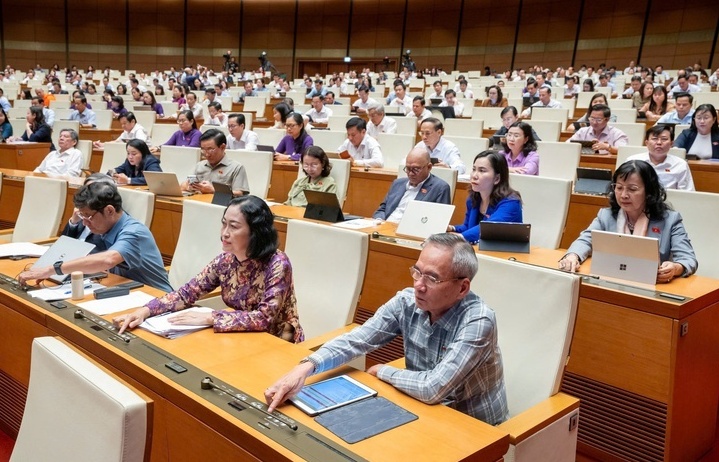Tax reduction for ambitious growth target
 |
The Ministry of Finance (MoF) has proposed reducing the corporate income tax (CIT) from the current 20 to 17 per cent, applicable to small and medium sized enterprises during 2017-2020. Why such a limited timescale?
The Party and the State always pay due heed to the development of small and medium sized enterprises (SMEs), particularly in the formulation of tax policies.
Accordingly, during 2014-2015, SMEs incurred a CIT rate of 20 per cent, whereas bigger ones shouldered 22 per cent.
From January 1, 2016 onwards, a CIT rate of 20 per cent is equally applied to all businesses, irrespective of size.
On April 29, 2016, leaders of the government as well as authorised management agencies and sectors attended a meeting with Ho Chi Minh City’s business community and set forth the target of having at least one million businesses by 2020. To realise this goal, the Ministry of Planning and Investment (MPI) is busy compiling a specialised Law on supporting SMEs.
The government has just enacted Resolution 35/NQ-CP on business support and development to 2020, in which the MoF was assigned to consider CIT reduction to help SMEs overcome hardships.
The 20 per cent rate was regulated in the Law on CIT, the resolution, therefore, can not set a new long-term CIT rate. Thereby, the MoF has proposed a limited timescale for the preferential 17 per cent applicable to SMEs.
We are considering a revision of the Law on CIT, focusing on issues such as the plausibility of a common CIT rate and whether preferential CIT rates will be further applied and to whom, and all these contents will be submitted to the National Assembly (NA) for a final decision.
Will this affect the state budget?
This largely depends on the criteria defining SMEs.
If the SME definition would include a maximum revenue of VND20 billion per year, as currently regulated in the CIT Law, the state budget would lose VND473 billion ($21.5 million) per year as, at present, businesses satisfying this criterion make up 86.2 per cent of the total number of businesses, but only contribute VND2.74 trillion ($125 million) in taxes per year.
If SMEs were described as those generating at most VND100 billion ($4.56 billion) in annual revenue, as stated in the draft version of the Law on supporting SMEs, the state budget would lose around VND1.5 trillion ($68.4 million) as businesses meeting this requirement make up 95.2 per cent of the total and contribute VN8.7 trillion ($397 million) in taxes annually.
Generally, the loss in taxes would not be significant, whichever definition and criteria are applied. By contrast, through applying the tax incentive, tens of thousands of new businesses would be set up each year, making greater contributions to state coffers that would more than offset the losses.
The MoF also proposed applying the 17 per cent CIT rate to start-up businesses. What is a start-up?
This issue was under discussion at a recent monthly government meeting because business start-ups have only emerged in Vietnam several years ago, leaving us no legal precedent as to their definition. The government has just assigned the Ministry of Science and Technology (MoST) to set concrete criteria for start-ups.
Does this mean that the 17 per cent CIT rate might not be immediately applicable to start-ups when the NA approves on providing tax measures to help businesses overcome hardships, because we need to wait for the MoST to present a workable definition for start-ups?
As most start-ups are of small and medium size, they will enjoy the preferential 17 per cent CIT rate immediately after the NA approves the Resolution.
In reality, the national programme to support an innovative start-up ecosystem to 2025 has regulated that support will be given to individuals and individual groups with start-up projects and start-up businesses having high growth potential based on new technology or business models.
The MoF piqued the interest of the business community when it proposed allowing firms to take profits from real estate transfers to offset losses incurred from business activities. Could you elaborate on this?
In reality, many businesses are operating across multiple sectors. It is encouraging that today many leading players, such as Vingroup, Hoa Phat, or SSI, began to venture into agriculture.
Agricultural investment proves highly risky, as its success depends not only on the output market, but on entirely external factors, such as the climate or the ebb and flow of epidemics.
To encourage agricultural investment, multiple support measures and policies need to be put in place. Therefore, in the financial field, we have proposed using profits from the transfer of real estate or investment projects to fill up the losses incurred in other production and business activities to help alleviate firms’ difficulties.
What the stars mean:
★ Poor ★ ★ Promising ★★★ Good ★★★★ Very good ★★★★★ Exceptional
Latest News
More News
- Trump's trade policies could shape Vietnam's economic outlook: Dragon Capital (November 15, 2024 | 16:56)
- Prioritising corporate governance for Vietnam’s sustainable growth (November 14, 2024 | 16:50)
- Vietnam eyes nuclear revival to bolster energy security (November 14, 2024 | 16:46)
- German businesses explore investments in Dong Nai (November 08, 2024 | 18:02)
- Vietnamese consumer sentiment outperforms regional averages (November 08, 2024 | 18:00)
- Exchange and interest rates forecast to remain stable after US election (November 07, 2024 | 14:04)
- Industrial real estate stocks benefit from US election results (November 07, 2024 | 13:56)
- 2024 sees $1.41 billion in fintech funding so far (November 07, 2024 | 08:13)
- Trump at 266 electoral votes, Harris at 195: US media (November 06, 2024 | 14:30)
- Hanoi targets digital and high-tech investment with upcoming event (November 06, 2024 | 13:28)




















 Mobile Version
Mobile Version